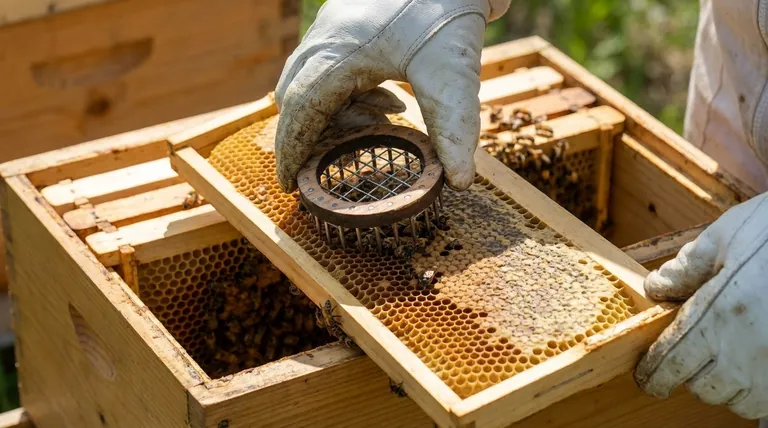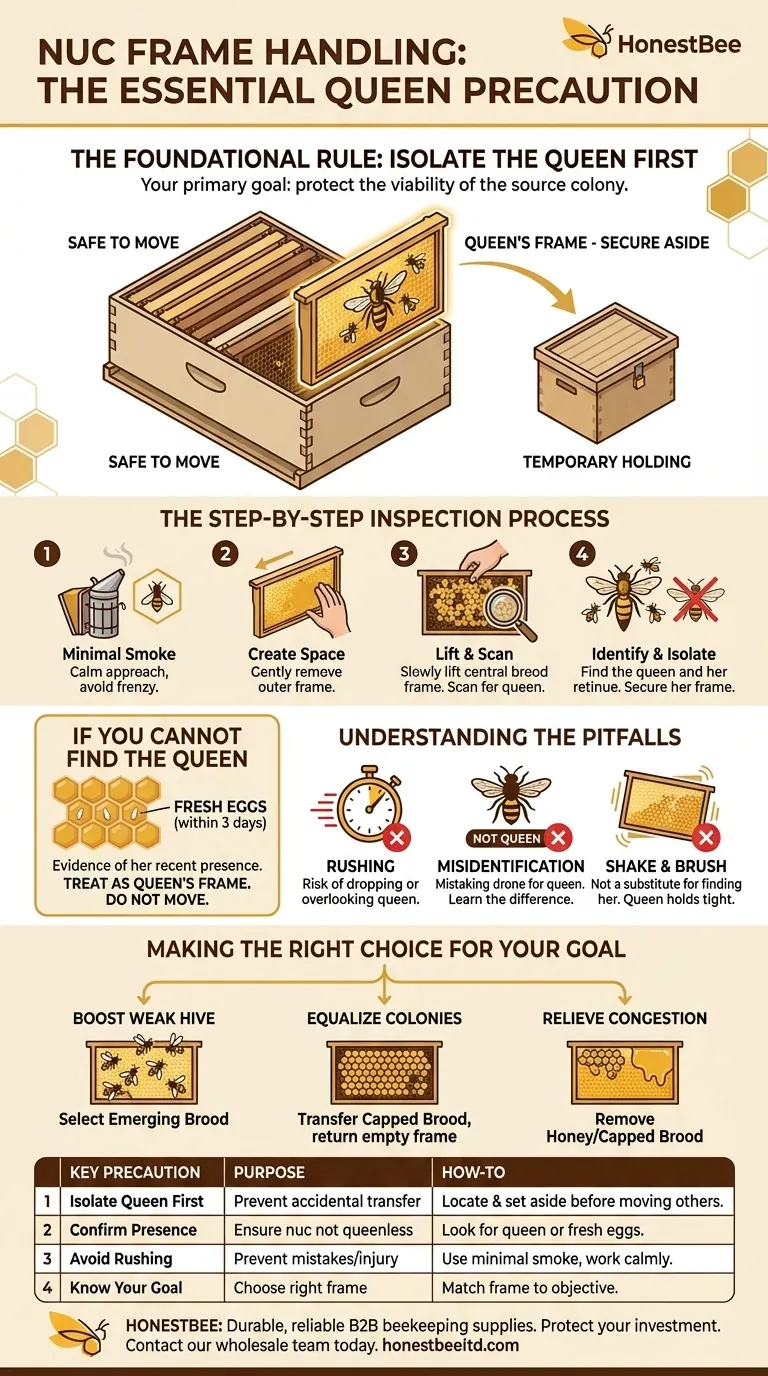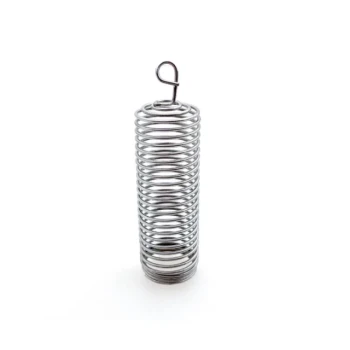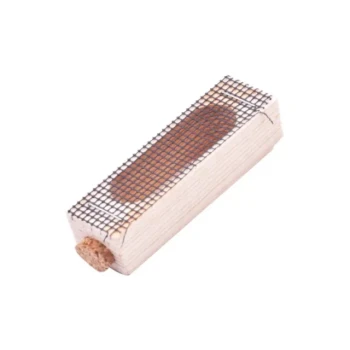The single most important precaution is to find the frame the queen is on and set it securely aside before you move any other frames. This simple act of isolating the queen is the only way to guarantee she is not accidentally transferred from her nucleus colony.
Your primary goal is not just to move frames, but to protect the viability of the source colony. The entire process should revolve around one principle: always know where the queen is before taking action.

The Foundational Rule: Isolate the Queen First
Transferring frames from a nucleus hive, or "nuc," is a common way to boost a weaker colony or start a new one. However, the success of this operation hinges on ensuring the queen of the nuc remains in her home.
Why This is Non-Negotiable
Accidentally moving the queen creates two potential disasters. The original nuc is now queenless and will perish unless it has the resources to raise a new one. The receiving colony, if it already has a queen, will likely see the newcomer as a threat and kill her.
The Step-by-Step Inspection Process
To handle frames safely, you must first locate the queen. This requires a calm, methodical approach.
- Use minimal smoke to avoid sending the bees, and the queen, into a frenzy.
- Gently remove an outer frame of honey or pollen to create working space.
- Slowly lift out one of the central brood frames.
- Scan both sides of the frame for the queen, who is larger and has a longer, more pointed abdomen than other bees.
- Look for her "retinue" — a circle of attendant bees facing her.
What to Do When You Find Her
Once you locate the queen, carefully place that frame back into the nuc box. You can then either place the entire nuc box aside or temporarily move her frame to a separate, secure box while you work.
This physical isolation is the only foolproof method. She is now accounted for, and you can confidently work with the remaining frames.
If You Cannot Find the Queen
It happens. If you cannot visually confirm the queen after a thorough search, look for her evidence: freshly laid eggs. These look like tiny grains of rice standing upright in the bottom of a cell.
Seeing fresh eggs confirms the queen was on that frame within the last three days. You should treat any frame with fresh eggs as the "queen's frame" and avoid moving it. Frames with only capped brood or honey are much safer to transfer.
Understanding the Pitfalls
Even a simple procedure has risks. Awareness is the best way to prevent a mistake that could cost you a colony.
The Danger of Rushing
The most common mistake is impatience. Beekeeping requires deliberate, calm movements. Rushing causes you to overlook the queen and increases the risk of dropping a frame, which can injure or kill her.
Misidentifying the Queen
Beginners often mistake a large drone (a male bee) for the queen. Drones are blocky and have large eyes that meet at the top of their head. A queen is more slender and elongated. Take the time to learn the difference.
The "Shake and Brush" Misconception
Some beekeepers will shake all the bees off a frame back into the nuc before moving it. While this can work, it is not a substitute for finding the queen first. A queen holds on tightly and may not be dislodged by shaking, leading to her accidental transfer.
Making the Right Choice for Your Goal
Your strategy depends on your objective. Once the queen's location is confirmed, you can proceed with confidence.
- If your primary focus is boosting a weak hive: Select a frame of "emerging brood" (where bees are starting to hatch) to provide an instant population boost to the receiving colony.
- If your primary focus is equalizing two colonies: Transfer a frame of capped brood from the strong nuc to the weaker hive, and you can move an empty drawn frame back to the nuc to give the queen space to lay.
- If your primary focus is relieving congestion in the nuc: Remove a frame of honey or fully capped brood to give the queen more laying space, preventing a swarm.
A methodical and patient approach ensures the health and productivity of both colonies.
Summary Table:
| Key Precaution | Purpose | How-To |
|---|---|---|
| Isolate the Queen First | Prevent accidental transfer and queen loss | Locate the queen on a frame and set it securely aside before moving any other frames. |
| Confirm Queen's Presence | Ensure the nuc is not left queenless | Look for the queen or evidence of fresh eggs (laid within 3 days). |
| Avoid Rushing | Prevent mistakes and injury to the queen | Use minimal smoke, work calmly and methodically. |
| Know Your Goal | Choose the right frame for the right outcome | Boost a weak hive with emerging brood; equalize colonies with capped brood. |
Protect your investment and ensure your apiary's success with the right equipment.
Handling nucs requires precision and care, just like choosing your beekeeping supplies. At HONESTBEE, we supply durable, reliable beekeeping supplies and equipment to commercial apiaries and distributors through our wholesale-focused operations. From hive tools to protective gear, our products are designed to support the meticulous work of professional beekeepers.
Let us help you build a stronger, more productive operation. Contact our wholesale team today to discuss your equipment needs and how we can support your business.
Visual Guide

Related Products
- Wood and Mesh Push-In Queen Cage
- Durable Galvanized Steel Spring Queen Bee Cage
- Professional Bamboo Queen Isolation Cage
- Professional Plastic Queen Excluder for Modern Beekeeping
- High Performance Plastic Queen Excluder for Beekeeping and Apiary Management
People Also Ask
- Why might bees reject a new queen? A Guide to Successful Queen Introduction
- What are key factors for successful beekeeping with a new queen? A Guide to Flawless Queen Introduction
- Are queen cages reusable? Yes, with proper cleaning for sustainable beekeeping.
- What is a push-in queen cage and how does it differ from standard cages? Achieve Higher Queen Acceptance Rates
- What happens when bees do not recognize a queen as part of their hive? The Deadly Process of Queen Rejection



















